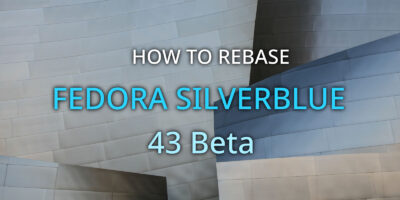This is a message from Fedora Project Leader Matthew Miller.
Hi everyone. If you saw my talk at DevConf.cz this year, you’ll remember I discussed the Fedora / Red Hat relationship, and specifically how Fedora has historically worked with new technologies that come our way through acquisitions made by our primary sponsor. Little did I know, but at that very moment, something huge was in the works, and when my plane landed back in Boston my phone blew up with messages about CoreOS joining Red Hat.
That’s obviously gigantic news, directly relevant to Fedora, since we are the project Red Hat depends on for operating-system level integration and innovation. Now, most of the news is about Kubernetes, OpenShift, Tectonic, and Quay — but there’s also Container Linux (the operating system formerly known just as “CoreOS”). At Red Hat Summit, the company announced and clarified a bunch of things around product and corporate plans. Now, it’s time for us to figure out how we can welcome and include the Container Linux community in the circle of Fedora Friends.
What does this mean for the Fedora community?
Good things! Container Linux is exciting, innovative, and has a passionate user and developer community. The people who built it are awesome and well-aligned with the Fedora community foundations.
The “Fedora Editions” strategy intentionally makes space for exploring emerging areas in operating system distributions. CoreOS will help us push that even further and bring new ways of doing things to the project as a whole.
What does this mean for Container Linux users?
More good things! I know this is kind of scary. Fedora CoreOS is going to be built from Fedora content rather than in the way it’s made now. It won’t necessarily be made in the same way we make Fedora OS deliverables today, though. No matter what, we absolutely want the CoreOS user experience of “container cluster host OS that keeps itself up-to-date and you just don’t worry about it.” Again, technical details are a discussion for elsewhere, but the goal is for existing Container Linux users to be as happy as — or happier than! — you are with the OS today.
And here’s the super-important thing: Fedora really is a community-driven project, and this means that you can get involved and directly influence how the future Fedora CoreOS works to meet your needs. If you’re interested and need help getting involved, don’t hesitate to talk to me, to the Join Fedora team, or to the developers and community people already working on the project.
What does this mean for Fedora Atomic Host and other deliverables?
This isn’t the place for technical details — see “what next?” at the bottom of this message for more. I expect that over the next year or so, Fedora Atomic Host will be replaced by a new thing combining the best from Container Linux and Project Atomic. This new thing will be “Fedora CoreOS” and serve as the upstream to Red Hat CoreOS.
Hey, so… “Fedora Core”!
Everything’s a circle, right? But, this has nothing to do with the Red Hat vs. external split that was Fedora Core and Extras back in the day. We absolutely do not want to regress to that kind of community divide. “Core” just happens to be a pretty catchy name component for an OS that fits the “small, focused base” concept. This concept is powerful and useful for today’s information technology and computing world, and we want to give it proper focus in Fedora.
Okay, so, what next?
Visit the new website at https://coreos.fedoraproject.org. The project is just getting started, so there’s not much there yet, but we do have an initial FAQ. If you have questions that aren’t answered, or just want to get involved, join in discussion on the new Discourse board, the dev mailing list at coreos@lists.fedoraproject.org, and on Freenode IRC in #fedora-coreos.






Jonathan
Was hoping to see something about rkt in the announcement too. Not least for the name opportunity: FedoRkt.
Matthew Miller
Someone else had this question too: https://discussion.fedoraproject.org/t/what-does-fedora-coreos-mean-for-fedora-and-rkt/78
Chris Daniels
I was a little confused about the distinctive Massachusetts sign in the picture. It reminded me first of the days when Andover.net acquired Freshmeat.net and Slashdot and I would regularly pass their HQ on the highway. Then of course MIT where FOSS started (curse you Silicon Valley, for stealing Route 128’s tech thunder!) Turns out the author just happened to be landing (at Logan, I assume). I know I’m getting old now that the simplest symbols bring a rush of memories. Actually I could be wrong and maybe that sign shape and style could be elsewhere along the East Coast or New England. (I was never one to get out much). Sorry Matt, I’m just riffing on “new technologies that come our way through acquisitions” and too little sleep.
Ryan Lerch
Nothing that deep, actually!
I did the image up after seeing Matthew’s title for the post, and for some reason made me think of the “Entering” signs that were everywhere in the New England area when I lived there.
Not sure about other parts of the US, but i can definitely tell you that we don’t have signs like that down here in Australia 😀
Nikato Muirhead
Are there any plans to finally get rid of RPM format, or will red hat burden this new OS with that legacy technology also ?
Stuart D Gathman
RPM is one of the best features, IMO. The most important part is the SRPM, pristine source code with dependencies and patches, so that you can build everything from source, like gentoo, but tailored to the distro, installed binaries signed, tracked and checksummed, and so on.
“Legacy technology” implies you have in mind some new packaging system that incorporates all these features and more. What do you have in mind?
jjjj
fedora is open source and all is ok